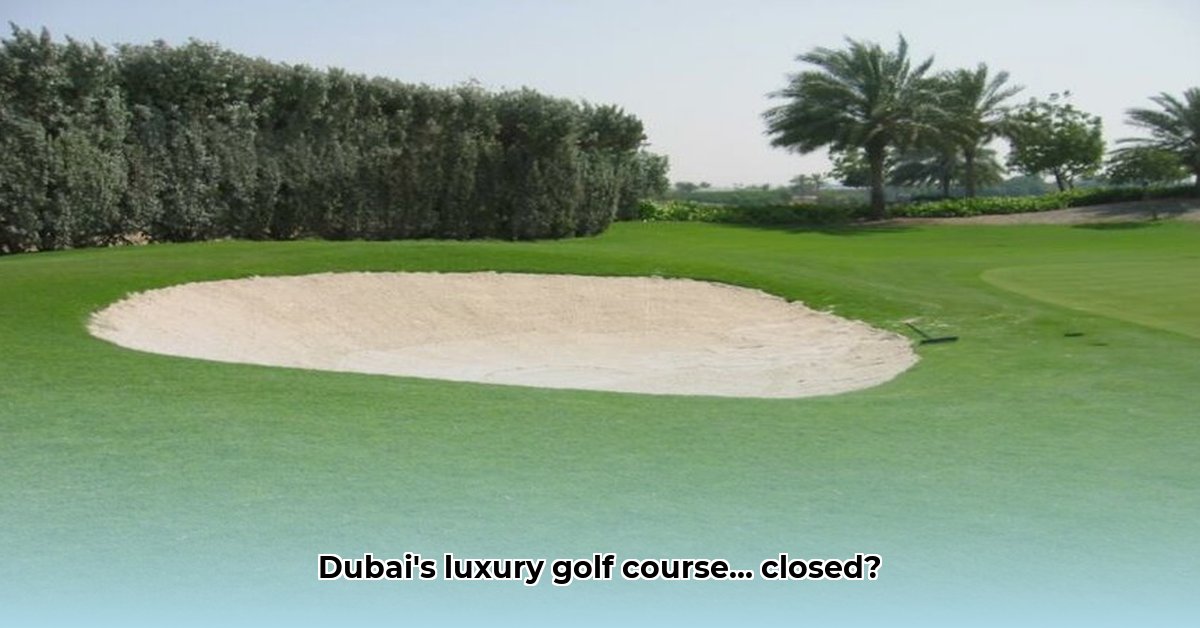In 2020, Dubai’s Al Badia Golf Club, a name synonymous with luxury and golfing excellence, closed its doors. This event sent ripples through the golfing community and raised pertinent questions about the sustainability of even high-end leisure facilities in a rapidly evolving economic landscape. What led to the demise of this prestigious course, and what lessons can be learned?
Al Badia Golf Club: More Than Just a Course
Al Badia wasn’t just another golf course; it was an experience. Designed by Robert Trent Jones II, it boasted 18 holes of championship-level play, set against the backdrop of Dubai’s stunning skyline. The club featured a luxurious clubhouse, multiple dining options, and was a popular venue for international tournaments, attracting both tourists and local golf enthusiasts. The closure, therefore, was a shock to many.
The Official Story vs. The Whispers
The Al Futtaim family, owners of the land, cited a shift in land use as the primary reason for the closure. The plan was to transform the area into a private garden, with the clubhouse becoming a private Majlis. However, this explanation hasn’t entirely silenced speculation. Rumors persist about underlying financial challenges and the irresistible allure of redevelopment in Dubai’s booming real estate market.
Possible Explanations: Decoding the Closure
Several factors could have contributed to Al Badia’s fate:
-
The Land Value Magnet: Dubai’s relentless pursuit of development has led to skyrocketing property values. Redeveloping the Al Badia land into luxury residences or commercial spaces could have presented a more lucrative prospect than maintaining the golf course, despite its popularity.
-
Economic Tides: The economic climate can significantly impact leisure businesses. A downturn in luxury spending, shifts in investor sentiment, or unforeseen financial burdens could have strained Al Badia’s resources.
-
Shifting Preferences: The golf industry itself is subject to change. Evolving golfer preferences, the emergence of newer, more innovative courses, or a general decline in golf’s popularity in the region could have affected Al Badia’s appeal.
The absence of a definitive explanation fuels ongoing debate within Dubai’s business and development circles.
The Ripple Effect: Impact Beyond the Fairway
The closure had consequences extending beyond the golfing community. It affected Dubai’s tourism sector, the golf industry in general, and the employees who relied on Al Badia for their livelihoods. While some staff members were reportedly absorbed into other InterContinental Hotels Group properties, the overall impact on jobs and the local economy remains a subject of concern.
Analyzing the Fallout: Stakeholder by Stakeholder
The impact of Al Badia’s closure can be categorized based on the stakeholders involved:
| Stakeholder | Short-Term Impact | Long-Term Impact |
|---|---|---|
| Golf Course Owners | Financial re-evaluation, market analysis, potential losses | More robust financial planning, diversification of offerings, sustainable practices, enhanced risk management |
| Dubai Tourism Authority | Temporary dip in high-end golf tourism, potential reputational concerns | Adaptation of tourism strategies to maintain Dubai’s appeal as a premier golfing destination |
| Investors | Review of investment portfolios, possible financial setbacks | Shift towards investment strategies focused on long-term market viability and economic resilience |
| Golf Professionals | Job displacement, career transition | Upskilling and adaptation to evolving industry trends, increased workforce flexibility |
Lessons from the Green: A Case Study in Risk
Al Badia’s story serves as a cautionary tale, highlighting the vulnerability of even well-established businesses in dynamic and competitive markets. It underscores the critical importance of proactive long-term planning, anticipating market shifts, and adapting to evolving economic realities.
Safeguarding Dubai’s Golf Future: Strategies for Sustainability
The closure of Al Badia Golf Club has illuminated the need for proactive strategies to mitigate risks and ensure the long-term sustainability of golf courses in Dubai. Addressing economic vulnerabilities and adapting to changing market dynamics are essential for securing the future of this important sector.
Unpacking the Vulnerabilities: The Challenges Faced
While official accounts pointed to economic pressures and declining membership, speculation surrounding land redevelopment and potential mismanagement persists. The lack of comprehensive transparency has fueled uncertainty.
Risks on the Horizon: Identifying Potential Threats
Al Badia faced a confluence of challenges, including financial instability due to high operating costs, declining membership numbers, evolving regulatory landscapes, and the ever-present threat of land redevelopment.
Proactive Risk Management: Building a Resilient Foundation
To thrive in Dubai’s competitive market, golf courses must prioritize proactive risk management:
| Risk Category | Likelihood | Impact | Mitigation Strategy |
|---|---|---|---|
| Financial Instability | High | High | Diversify revenue streams, secure long-term funding, implement stringent cost-control measures |
| Declining Membership | Medium | Medium | Enhance member experience, modernize facilities, offer flexible membership packages tailored to diverse needs |
| Liability for Injuries | Medium | High | Comprehensive insurance coverage, rigorous safety protocols, thorough staff training |
| Regulatory Compliance | Medium | Medium | Stay abreast of regulatory changes, proactive engagement with authorities, ensure full compliance |
| Land Redevelopment | Low | High | Proactive land use planning, robust legal protections, strategic engagement with city planning authorities |
Steps to Minimize Risk: A Practical Guide
- Prioritize Financial Health: Implement comprehensive financial planning, diversify income sources beyond membership fees, and explore alternative revenue streams.
- Elevate Member Experience: Focus on enhancing the member experience through facility upgrades, engaging social events, and fostering a strong sense of community.
- Navigate the Regulatory Landscape: Stay informed about evolving regulations and cultivate strong relationships with relevant authorities.
- Proactive Land Use Planning: Engage with city planners and secure legal protections to safeguard against potential redevelopment pressures.
- Comprehensive Insurance Coverage: Secure robust liability insurance to protect against unforeseen incidents and potential financial losses.
Dubai’s Golf Courses: Forging a Sustainable Future
The closure of Al Badia Golf Club serves as a catalyst for change, prompting Dubai’s golf industry to embrace innovative strategies and prioritize long-term sustainability.
Learning from the Past: Key Takeaways from Al Badia
While the precise reasons for Al Badia’s closure remain shrouded in some mystery, the event underscores the need for Dubai’s golf courses to adapt and innovate to remain competitive.
Building a More Resilient Industry: Essential Strategies
- Diversification is Key: Explore a wider range of revenue streams beyond traditional green fees, including enhanced dining options, retail partnerships, and event hosting.
- Embrace Sustainability: Implement environmentally conscious practices, such as water conservation and responsible fertilizer use, to minimize environmental impact and reduce operating costs.
- Innovation in Course Design: Offer flexible course options and incorporate technology to cater to evolving golfer preferences and enhance the overall playing experience.
- Community Engagement: Cultivate strong relationships with local communities to foster goodwill, generate local revenue, and build long-term loyalty.
- Financial Prudence: Diversify income sources and implement robust financial planning to mitigate economic risks and ensure long-term financial stability.
Lessons in Action: Forging a Path Forward
- Recognize the vulnerability of even high-end facilities to market forces.
- Understand the critical interplay between land values, economic conditions, and member preferences.
- Prioritize diversification, sustainability, and flexibility in facility design and operations.
- Develop proactive plans and cultivate strong community relationships to build resilience and ensure long-term success.
Charting a New Course: A Sustainable Future for Dubai Golf
Dubai’s golf industry possesses the potential to achieve long-term resilience and sustainability by embracing innovation, prioritizing community engagement, and adapting to the evolving needs of the market. By learning from the past and embracing a proactive approach, Dubai can solidify its position as a premier golfing destination for years to come.
The Impact of Dubai Golf Course Closure: Exploring Tourism and Industry
Key Takeaways:
- Al Badia Golf Club’s closure in 2020 was a surprise, considering that membership and rounds played were initially strong.
- The closure’s reasons center on the Al Futtaim family’s land-use priorities.
- Repurposing the land as a private area showcases complex economic decisions.
- Transparency and community engagement are vital for future projects in Dubai.
Al Badia’s Closure
Al Badia Golf Club, designed by Robert Trent Jones II, closed in 2020 leading to inquiries about its financials. Membership conflicted, and uncertainty was created.
Unraveling the Golfing Mystery
Al Badia’s financial performance before closing goes against official explanations, resulting in speculation about Al Futtaim family plans.
Analyzing the Impact
Factors like land value, economy, and decision-making were involved. Transparency and community engagement are vital.
| Risk Factor | Likelihood | Impact | Mitigation Strategies |
|---|---|---|---|
| Negative publicity from closure | Medium | Medium | Transparency; community engagement. |
| Loss of tourism revenue | Low | Low | Diversification of tourism offerings. |
| Reduced golfer participation | Low | Low | Marketing of alternative facilities; promoting golf |
- Unforgettable: Talking Stick Golf Club Review – Desert Golfing Redefined - November 17, 2025
- Discover Talega Golf Club: Championship Golf & Spanish Hospitality Awaits! - November 15, 2025
- Is Strawberry Farms Golf Club Orange County’s Best Kept Secret? - November 13, 2025









